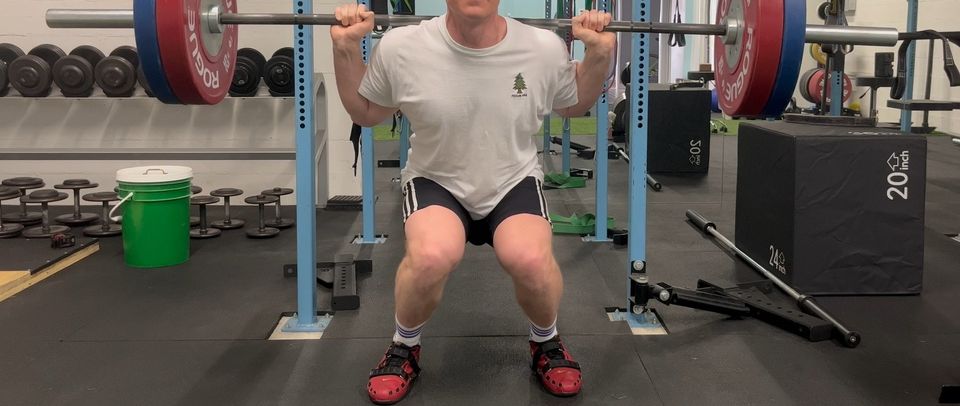It's time to stop knocking on knock knees: DKV and ACL injury

Here is the second of the knee valgus articles! For this article we will be looking at dynamic knee valgus (DKV) and its relation to anterior cruciate ligament (ACL) injury. This topic is more focused on activities outside of the gym - since ACL injury and squatting is extremely rare and squats are usually a part of ACL injury rehab.
The mechanism of non-contact ACL injury is largely influenced by knee valgus, which was reported in 81% of analysed injuries1. I can see how this may raise some concern around DKV and ACL injury when looking at the face value of this study; however, this study did not assess if these athletes had presented with DKV as a movement pattern before the injuries. Therefore the study cannot determine if presenting with DKV will lead to ACL injury, since it was only assessing when the injuries occurred. Also, it does not take fatigue, training load, and capacity into consideration (this will be talked about later). Personally this raises some questions on my end about how training in knee valgus may potentially build up tolerance to the position. The knee valgus may be an unavoidable position in sport and not a movement that the athletes would normally produce while doing a single leg drop test or single leg squat. To sum up the above, this study doesn’t show whether or not knee valgus is inherently a bad position to be in, just that it often occurs during non-contact ACL injuries.
Luckily we have some prospective studies looking at athletes who present with DKV assessing if they sustain more ACL injuries than those who don’t present with it! These studies have shown that DKV does not have a relationship with ACL injury and cannot predict athletes who sustain an ACL injury vs. those who don’t1,2. A question that has been raised is whether or not there may be a breaking point of amount of DKV that leads to ACL injury2. These are good questions and should be studied; however, right now we cannot say that there is a relationship between DKV and ACL injury.
If you are still concerned about DKV - despite a growing body of evidence showing that it isn’t bad - and want to change it, a common intervention is to work on hip strength. Calling back to the last post where we discussed knee pain and DKV, we discussed how hip focused interventions don’t change how the knee moves4-8. It would really simplify things if changing knee valgus was as simple as becoming an absolute glute god, but sadly the dumptruck doesn’t change how your knees move. Looking at this a little bit deeper, I can see the theoretical framework that brought people to think about glute interventions helping with knee valgus; however, if we look at the evidence that directly tests the relationship between hip strength and DKV, we find that there is no clear relationship, so weak glutes don't resut in DKV9,10. This makes me wonder why the focus on strengthening the glutes to change how someone’s knee moves is so widely used and studied if the foundation for those interventions is shown to be non-existent.
Earlier I raised the question about training in valgus and if that may be protective. Exploring this idea, a systematic review11 which looked at 57 other studies found that there is a relationship between training load and injury. The results were that a moderate training load was found to have a protective effect11. A very important point here is that a moderate training load is RELATIVE. The more that someone can do, the more training volume and load they can handle with it still being considered moderate. Proper progressive overload should be followed to increase capacity and thus increase resilience to injury11.
The link between DKV and ACL injury just isn’t there. Other factors in terms of injury may be training load, capacity and fatigue, with some evidence showing that increasing capacity can be protective. It would be interesting to see some evidence that trains people in knee valgus to see if they can build up more capacity to DKV and if that would decrease injury rates.
Just like the previous article, it is shown that dynamic knee valgus is not bad. Now get out there and do some movement!
- Della Villa F, Buckthorpe M, Grassi A, Nabiuzzi A, Tosarelli F, Zaffagnini S, Della Villa S. Systematic video analysis of ACL injuries in professional male football (soccer): injury mechanisms, situational patterns and biomechanics study on 134 consecutive cases. Br J Sports Med. 2020 Dec;54(23):1423-1432. doi: 10.1136/bjsports-2019-101247. Epub 2020 Jun 19. PMID: 32561515.
- Cronström A, Creaby MW, Ageberg E. Do knee abduction kinematics and kinetics predict future anterior cruciate ligament injury risk? A systematic review and meta-analysis of prospective studies. BMC Musculoskelet Disord. 2020 Aug 20;21(1):563. doi: 10.1186/s12891-020-03552-3. PMID: 32819327; PMCID: PMC7441716.
- Nilstad A, Petushek E, Mok KM, Bahr R, Krosshaug T. Kiss goodbye to the 'kissing knees': no association between frontal plane inward knee motion and risk of future non-contact ACL injury in elite female athletes. Sports Biomech. 2021 Apr 28:1-15. doi: 10.1080/14763141.2021.1903541. Epub ahead of print. PMID: 33906580.
- Rabelo NDDA, Lucareli PRG. Do hip muscle weakness and dynamic knee valgus matter for the clinical evaluation and decision-making process in patients with patellofemoral pain? Braz J Phys Ther. 2018 Mar-Apr;22(2):105-109. doi: 10.1016/j.bjpt.2017.10.002. Epub 2017 Nov 8. PMID: 29157738; PMCID: PMC5883958.
- Wilczyński B, Zorena K, Ślęzak D. Dynamic Knee Valgus in Single-Leg Movement Tasks. Potentially Modifiable Factors and Exercise Training Options. A Literature Review. Int J Environ Res Public Health. 2020 Nov 6;17(21):8208. doi: 10.3390/ijerph17218208. PMID: 33172101; PMCID: PMC7664395.
- Lopes TJA, Simic M, Myer GD, Ford KR, Hewett TE, Pappas E. The Effects of Injury Prevention Programs on the Biomechanics of Landing Tasks: A Systematic Review With Meta-analysis. Am J Sports Med. 2018 May;46(6):1492-1499. doi: 10.1177/0363546517716930. Epub 2017 Jul 31. PMID: 28759729; PMCID: PMC6604048.
- Palmer K, Hebron C, Williams JM. A randomised trial into the effect of an isolated hip abductor strengthening programme and a functional motor control programme on knee kinematics and hip muscle strength. BMC Musculoskelet Disord. 2015 May 3;16:105. doi: 10.1186/s12891-015-0563-9. PMID: 25935843; PMCID: PMC4424529.
- Ferber R, Kendall KD, Farr L. Changes in knee biomechanics after a hip-abductor strengthening protocol for runners with patellofemoral pain syndrome. J Athl Train. 2011 Mar-Apr;46(2):142-9. doi: 10.4085/1062-6050-46.2.142. PMID: 21391799; PMCID: PMC3070501.
- Alzahrani AM, Alzhrani M, Alshahrani SN, Alghamdi W, Alqahtani M, Alzahrani H. Is Hip Muscle Strength Associated with Dynamic Knee Valgus in a Healthy Adult Population? A Systematic Review. Int J Environ Res Public Health. 2021 Jul 19;18(14):7669. doi: 10.3390/ijerph18147669. PMID: 34300118; PMCID: PMC8304771.
- Dix J, Marsh S, Dingenen B, Malliaras P. The relationship between hip muscle strength and dynamic knee valgus in asymptomatic females: A systematic review. Phys Ther Sport. 2019 May;37:197-209. doi: 10.1016/j.ptsp.2018.05.015. Epub 2018 May 25. PMID: 29859898.
- Eckard TG, Padua DA, Hearn DW, Pexa BS, Frank BS. The Relationship Between Training Load and Injury in Athletes: A Systematic Review. Sports Med. 2018 Aug;48(8):1929-1961. doi: 10.1007/s40279-018-0951-z. Erratum in: Sports Med. 2020 Jun;50(6):1223. PMID: 29943231.

Member discussion